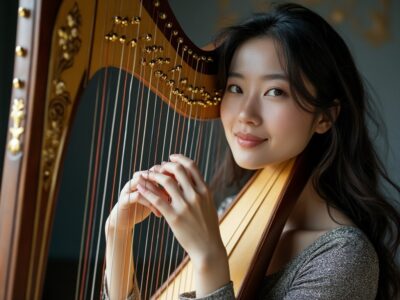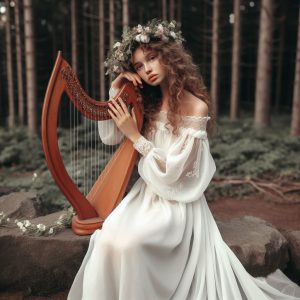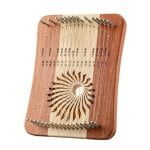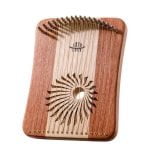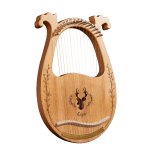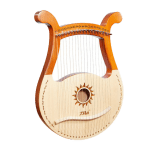A lovely string instrument with a regal sound is the lyre harp. Plucking the vibrating strings to produce distinct, ringing notes gives it its seductive tone. Can you, however, play entire chords on the harp lyre instead than just single notes? We’ll examine the opportunities and difficulties of playing the chordal harp lyre in this post.
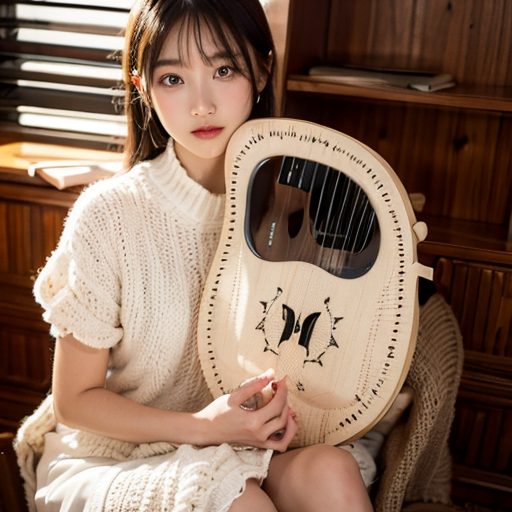
The Basics of Harp Structure
First, it’s critical to comprehend the lyre harp’s physical design. The soundbox, neck, strings, tuning pegs, and bridge are the essential components. A typical harp lyre has seven to ten strings. The soundbox is where the strings are fastened, and they extend up the neck to the tuning pegs. At the bridge, the bass and melody strings come together.
Because of this arrangement, the strings are not placed how they would be on a guitar fretboard, but rather linearly. Thus, chord construction differs from playing an instrument like the piano or guitar in terms of technique.
Basic Chord Theory
On stringed instruments, chords are built by playing multiple notes simultaneously. The foundation of chords is the triad which combines three notes from a scale played together. Major and minor chords have distinct moods based on the combination of notes in their triad. Extensions like the 7th, 9th, and 13th can make more complex jazzy chords.To play chords on a harp lyre, you need to pluck across multiple strings at the same time. This lets you sound groups of notes from the scale to form harmonious triads and expanded chords. Mastering chord changes allows you to support melodies and create interesting progressions.
Positioning Your Hands
Placing your hands correctly is essential to performing lyre harp chords. Both of your hands—left and right—will be required. Either the fingers can be flat over several strings, or they can wrap around and pluck using a loop grip.
To pluck the notes effortlessly, position your hands in the proper chord shape above the strings. You can play complex chords without looking down by presetting the notes with your finger location. You can harmonize with your melody by skillfully switching between chord fingerings.
Easy Chord Progression to Start
Let’s go through a simple I-IV-V-I chord progression in the key of C to get started with harp lyre chords.
The I chord is the C major triad – C E G. Place your left fingers on these 3 notes.
The IV chord is F major – F A C. Shift your right fingers to this shape.
The V chord is G major – G B D. Move your left hand here.
Return to the I C major chord with your right hand to complete the progression.
Strum through this I-IV-V-I sequence slowly. Listen to how the chords create a satisfying accompaniment. Once comfortable, try changing up the strumming pattern to create different vibes.
Tips for Fuller Sounding Chords
Here are some tips to make your lyre harp chords sound richer:
- Use 3-4 fingers to pluck multiple strings at once. This allows you to hit all the notes of the chord simultaneously.
- Incorporate open strings into chords to add ringing tones. Let some strings vibrate freely.
- Strum closer to the bridge for brighter, sharper chords. Plucking closer to the neck produces softer tones.
- Hold chords for a couple beats to let them ring out. Quick staccato strums diminish the harmonic effect.
- Try arpeggiating chords by plucking notes separately to create a cascading harp effect.
- Experiment with chord inversions by moving the lowest note up an octave. This varies the melody and harmony.
Expanding the Fretboard with Capos
Capos are useful tools that can be used to reduce the vibrating string length by being fastened to the harp lyre neck. This enables you to access new chord patterns, progressions, and keys rapidly. Typically, melody harp lyres include a simple capo. However, there are more complex partial caps available that enable rapid chord substitutions.
Learning Chord Theory
Take some time to learn chord structure in various keys and scales to realize the full potential of each chord. Discover the typical chord progressions and relationships between the chords in the music you desire to perform. Gaining an understanding of music theory will enable you to explore with different harmonies and apply chords with confidence.


